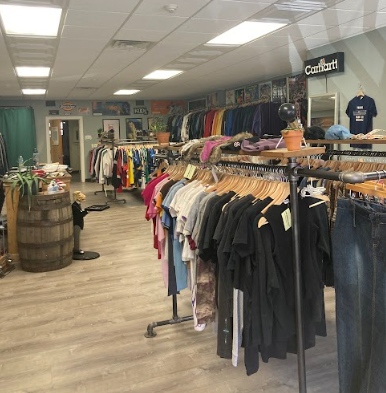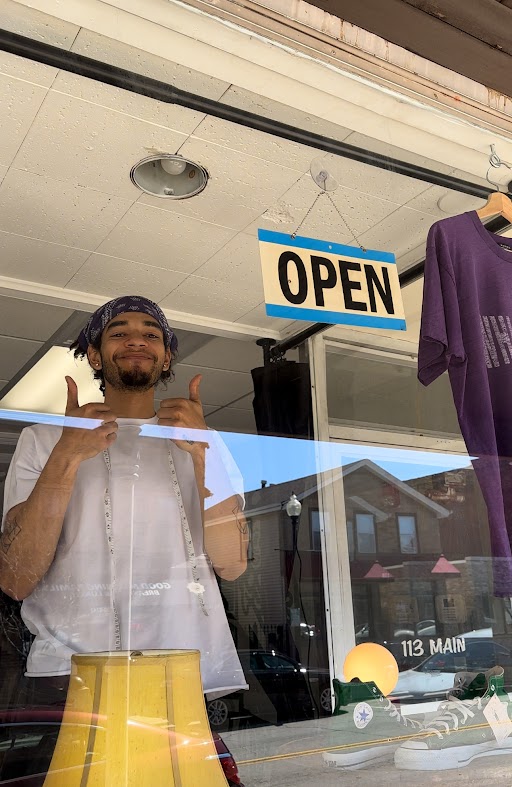West Chicago’s thrift store The Whistle Stop opened the doors of their new location at 113 Main Street, West Chicago on March 9 after upsizing from their previous site. The Whistle Stop resells vintage clothing items found in thrift stores in and out of the state. Thrifted items are available to customers in store, on their website or on their Depop platform.
22-year-old founder and owner Isaac Nelson opened the business over a year ago as a way to exercise his love for thrifting and vintage items, a passion that dates back to childhood.
“My dad is super into antiques. He’s a big collector of anything old, rusty basically. So I kind of grew up around a lot of thrift stores, a lot of garage sales, estate sales, flea markets, all of it,” said Nelson. “That was kind of our bond growing up.”
At The Whistle Stop, Nelson is meticulous with style and presentation, incorporating his love for clothes with his love for thrifting to create a cohesive brand. The store is organized methodically and offers a visually gratifying experience for customers.
“A lot of thrift stores, Goodwill, Savers [don’t] look good. It’s just a bunch of random stuff thrown together. I try my best to make our store look like a retail store so that people respect it as a retail store,” said Nelson. “I think that presentation is everything.”
After over a year being in business, The Whistle Stop has accumulated their primary customer demographic of young people. This is a small example of the way that thrifting and secondhand shopping has been gaining traction in younger generations everywhere.
“[People from] 15 to 25, those are my customers,” said Nelson. “It’s all young people. Young people run this business.”
Amplified via social media, thrifting has been marketed as the intersection of environmental consciousness and a way to find stylish clothing for less.
As trends of vintage style clothing appear on media feeds, users of popular social media sites, primarily young people, flock to local thrift stores not only to simply partake in the current trend, but to put their money and time towards stylish, good-quality items that don’t actively worsen the state of the environment like that of fast-fashion.
As an owner of a thrift store, Nelson recognizes that thrifting strays away from the current standard for buying clothes; while fast-fashion and major corporations prioritize profits and negate quality or sustainability, secondhand shopping offers an alternative.
Today’s clothing industry is heavily centered around planned obsolescence, which is intentionally designing products to have a limited lifespan in order to increase sales of new items and latest upgrades. As a thrift store owner, Nelson firmly believes in sustainable consumption of clothing, which starkly contrasts with the current fashion industry norm.
“100 years ago when they made a piece of clothing, it was supposed to last your whole life, and people made it last. If it had a hole you fixed it. If it had a stain you get it out, and I think somewhere over time, we’ve kind of lost that ideology. I’m happy to see that it’s kind of coming back because we already have so much stuff,” said Nelson.

As an alternative to buying brand new items, the thrifting and secondhand shopping option offers many other advantages than just owning items of consistent, long-term quality, such as benefiting the environment.
“There are endless amounts of landfills out there just full of textile waste, and a lot of it’s usable. A lot of it’s good quality fabrics and good name brand stuff that people just didn’t want anymore. Shopping secondhand, you get to save a lot on the amount of waste that we’re producing,” said Nelson. “Producing more stuff is horrible for the environment.”
And as prices go up, not only in fashion but in every aspect of the current world, shopping secondhand can be a valuable way to save a considerable amount of money.
“In today’s economy, saving money is great because there’s a lot of people that are struggling to make ends meet, and I think that if you can shop secondhand, you’re saving money. You’re helping your own pockets. You’re also helping the environment. There’s really no losers besides the big corporations that were trying to scam you in the first place,” said Nelson. “[By] shopping secondhand you get to save a lot on the amount of waste that we’re producing in landfills as well.
As thrifting and secondhand shopping are increasingly normalized by social media trends and brought into the mainstream by today’s youth, Nelson hopes to see society continue to rid of the wasteful, fast-fashion centric tendencies and progress into an ideology focused on sustainability and better quality clothing.
“I think that this industry is going to grow very big in the next five to 10 years just because of the fact that we only have so many resources on our planet, and having to remake all the things that are just being thrown away, you have to remake them and worse quality,” said Nelson. “I think secondhand everything, not just clothes, is the future.”









